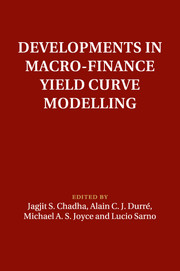Book contents
- Frontmatter
- Contents
- List of figures
- List of tables
- List of contributors
- Foreword
- Preface
- 1 Editors' introductory chapter and overview
- Part I Keynote addresses
- Part II New techniques
- 6 Compound autoregressive processes and defaultable bond pricing
- 7 Yield curve dimensionality when short rates are near the zero lower bound
- 8 The intelligible factor model: international comparison and stylized facts
- 9 Estimating the policy rule from money market rates when target rate changes are lumpy
- 10 Developing a practical yield curve model: an odyssey
- Part III Policy
- Part IV Estimating inflation risk
- Part V Default risk
- Index
8 - The intelligible factor model: international comparison and stylized facts
from Part II - New techniques
Published online by Cambridge University Press: 05 February 2014
- Frontmatter
- Contents
- List of figures
- List of tables
- List of contributors
- Foreword
- Preface
- 1 Editors' introductory chapter and overview
- Part I Keynote addresses
- Part II New techniques
- 6 Compound autoregressive processes and defaultable bond pricing
- 7 Yield curve dimensionality when short rates are near the zero lower bound
- 8 The intelligible factor model: international comparison and stylized facts
- 9 Estimating the policy rule from money market rates when target rate changes are lumpy
- 10 Developing a practical yield curve model: an odyssey
- Part III Policy
- Part IV Estimating inflation risk
- Part V Default risk
- Index
Summary
8.1 Introduction
Factor models of yield curve dynamics pursue different objectives. Among other things they are used for forecasting, to study the effects of different types of economic shocks, or to reduce complexity while capturing the main features of changes in the shape of the yield curve. Depending on their purpose the models may vary along different dimensions, but their common denominator is a dynamic specification for a small number of factors and a mapping relating the factors to the yield curve.
In this chapter we use a factor model to identify a set of stylized facts of yield curve dynamics across countries. The model is designed to capture the joint movement of yield curve factors. It aims at exploring the impact of a shock to a single factor over the entire yield curve. Our approach therefore provides an answer to questions like “How does a shock to the long-term interest rate propagate over time over the entire maturity range?”
The model separates the cross-sectional and the intertemporal relationships of the yield curve into factors on the one hand, and a dynamic equation for the development of the factors on the other hand. The innovations that drive the factors are serially uncorrelated, independent random variables and are therefore genuine, clean shocks.
- Type
- Chapter
- Information
- Developments in Macro-Finance Yield Curve Modelling , pp. 200 - 215Publisher: Cambridge University PressPrint publication year: 2014



